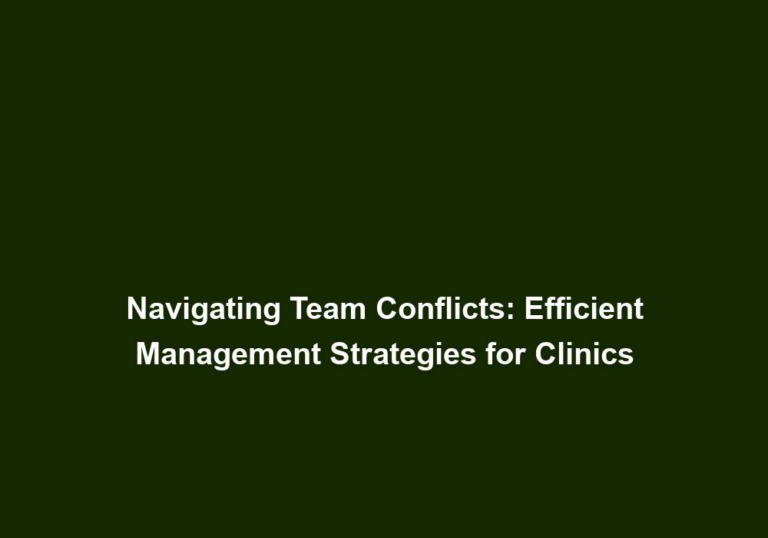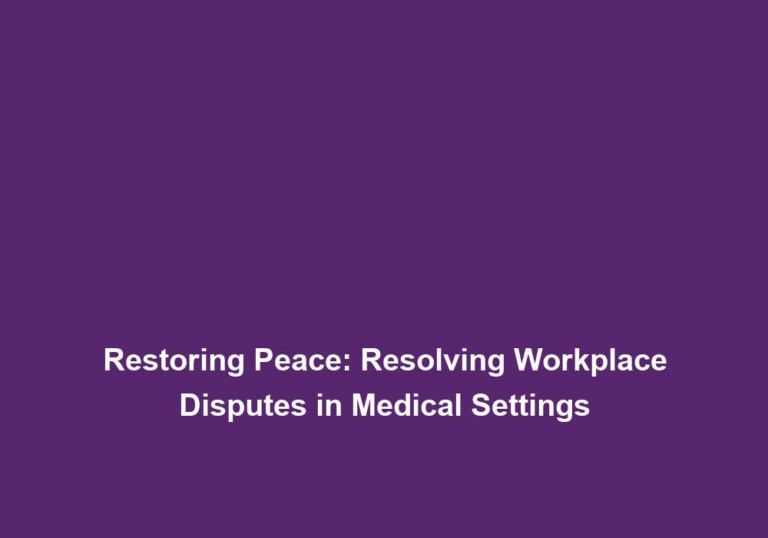Balancing the Scale: Mediation Skills for Resolving Staff Conflicts
In any workplace, conflicts among staff members can arise from various factors, such as differences in personalities, work styles, or competing interests. These conflicts can have a negative impact on team dynamics, productivity, and overall workplace morale. As a result, developing effective mediation skills becomes crucial for leaders and managers to address and resolve these conflicts in a fair and efficient manner.
Understanding the Role of a Mediator
A mediator is an impartial third party who helps facilitate communication and negotiation between conflicting parties. Their primary objective is to guide the parties involved towards a mutually agreeable resolution, where each party feels heard and valued. By acting as a neutral intermediary, a mediator creates a safe space for open dialogue and allows for a fair and balanced process.
In order to effectively fulfill their role, a mediator must possess strong interpersonal and communication skills. This includes active listening, empathy, and the ability to remain unbiased. By embodying these qualities, a mediator can establish trust and rapport with the conflicting parties, creating a conducive environment for conflict resolution.
Active Listening: The Key to Effective Mediation
One of the fundamental skills a mediator must possess is active listening. Active listening involves fully focusing on and comprehending what each party is saying, both verbally and non-verbally. It requires the mediator to remain neutral and non-judgmental, allowing each party to express their concerns and perspectives openly.
To demonstrate active listening, a mediator can use techniques such as paraphrasing, summarizing, and reflecting feelings. By restating and summarizing what each party has stated, the mediator ensures that both parties feel understood and acknowledged. This not only helps to clarify any misunderstandings but also validates the emotions and perspectives of each party involved.
In addition to verbal cues, a skilled mediator pays attention to non-verbal cues, such as body language and tone of voice. These cues provide valuable insights into the emotional state of the parties involved and help the mediator navigate the underlying dynamics of the conflict. By actively listening and observing, a mediator can foster a sense of trust and empathy, which is essential for resolving conflicts.
Creating a Safe and Respectful Environment
In order to encourage open communication, a mediator must establish a safe and respectful environment where all parties feel comfortable expressing their thoughts and emotions. This can be achieved by setting ground rules at the beginning of the mediation process, emphasizing the importance of treating each other with respect and maintaining confidentiality.
Additionally, the mediator should ensure that everyone has equal opportunity to speak, without interruptions or distractions. This creates an atmosphere of fairness and promotes active participation from all parties involved. To further enhance the sense of safety, the mediator can provide assurance that any information shared during the mediation process will be kept confidential, unless agreed otherwise.
By creating a safe and respectful environment, a mediator encourages the parties to engage in open and honest communication. This allows for the exploration of underlying issues and interests, which is crucial for finding a resolution that addresses the root causes of the conflict.
Identifying Underlying Interests and Needs
As a mediator, it is crucial to dig deeper into the underlying interests and needs of each party involved in the conflict. Often, surface-level disagreements may stem from deeper-rooted issues or unmet needs. By exploring these underlying interests, a mediator can help the parties identify common ground and work towards a mutually beneficial solution.
To facilitate this process, the mediator can ask open-ended questions that encourage the parties to express their concerns, desires, and motivations. This helps to uncover the core issues at the heart of the conflict and enables the mediator to guide the conversation towards finding a resolution. By understanding the underlying interests and needs, a mediator can assist the parties in brainstorming potential solutions that address their concerns effectively.
In addition to individual interests, a mediator also considers the collective interests of the team or organization. By aligning the resolution with these broader interests, the mediator can ensure that the outcome contributes to the overall well-being and success of the workplace.
Facilitating Effective Communication
Mediation is all about facilitating effective communication between conflicting parties. A mediator should encourage active and respectful dialogue, ensuring that each party has an opportunity to express their viewpoint without interruption. It’s important to promote constructive conversation that focuses on understanding rather than blaming.
Furthermore, the mediator should pay attention to non-verbal cues, such as body language and tone of voice, which can provide valuable insights into the emotional state of the parties involved. By addressing emotions and encouraging empathy, the mediator can help foster understanding and build bridges between conflicting parties.
To enhance communication, a mediator can also introduce techniques such as “I” statements, which encourage individuals to express their feelings and perspectives without attacking or blaming others. This helps to create a non-confrontational atmosphere and promotes a more collaborative approach to conflict resolution.
Exploring and Evaluating Potential Solutions
Once the underlying interests and needs have been identified, a mediator can guide the parties towards exploring potential solutions together. This requires brainstorming and evaluating various options that address the concerns of all parties involved.
To facilitate this process, the mediator can encourage creative thinking and generate a list of possible solutions. It’s important to emphasize that not all solutions need to be mutually exclusive, and compromises may be necessary. By focusing on the desired outcome, rather than individual positions, the mediator can help the parties find middle ground and overcome impasses.
During the evaluation of potential solutions, the mediator can assist the parties in considering the pros and cons of each option. This helps to ensure that the final resolution is practical, realistic, and capable of meeting the needs of all parties involved. The mediator can also help the parties prioritize their interests and identify trade-offs that may be necessary for reaching a mutually acceptable solution.
Reaching a Mutually Agreeable Resolution
The ultimate goal of mediation is to reach a mutually agreeable resolution that satisfies the interests and needs of all parties involved. The mediator should summarize the common points of agreement and guide the parties towards drafting a written agreement or action plan.
It is crucial for all parties to actively participate in formulating the resolution, as this enhances their sense of ownership and commitment to the outcome. The mediator should ensure that the resolution is clear, specific, and realistic, with identified timelines and responsibilities. By having a written agreement, the parties have a reference point to hold themselves accountable and prevent future conflicts.
The Lasting Impact of Mediation
Beyond resolving the immediate conflict, effective mediation skills can have a lasting impact on workplace dynamics. By promoting open communication, understanding, and collaboration, mediation fosters a positive work environment where conflicts are handled constructively.
Moreover, mediation promotes the development of essential skills among staff members, such as active listening, empathy, and problem-solving. These skills not only contribute to conflict resolution but also enhance overall teamwork and productivity. When employees feel heard and valued, they are more likely to engage in effective communication and collaboration, leading to a more positive and productive work environment.
Conclusion
Mediation skills play a crucial role in balancing the scales and resolving staff conflicts in a fair and efficient manner. By actively listening, creating a safe environment, identifying underlying interests, and facilitating effective communication, a skilled mediator can guide conflicting parties towards a mutually agreeable resolution. The impact of mediation extends beyond conflict resolution, fostering a positive work environment and equipping staff members with essential skills for future challenges.






